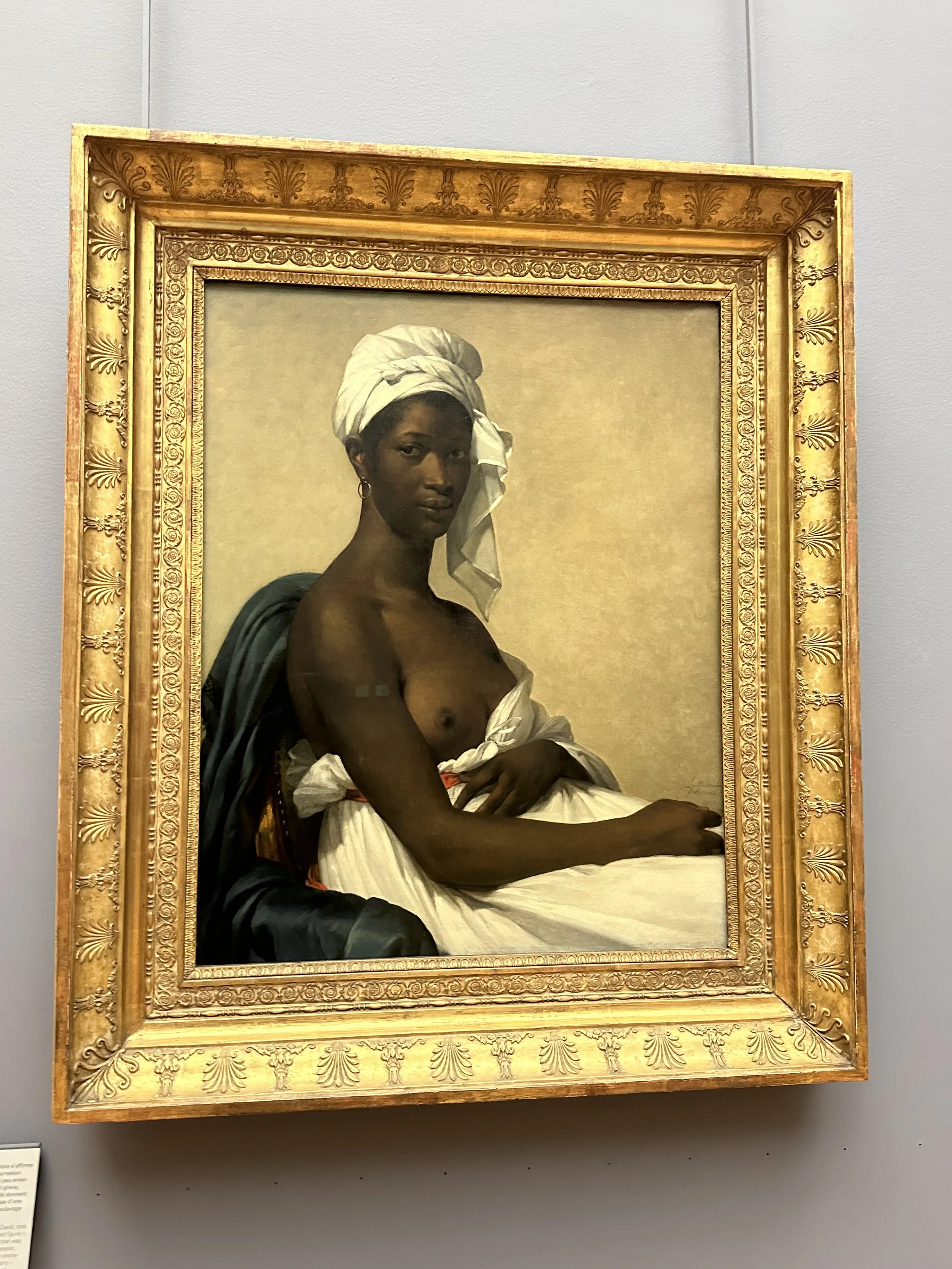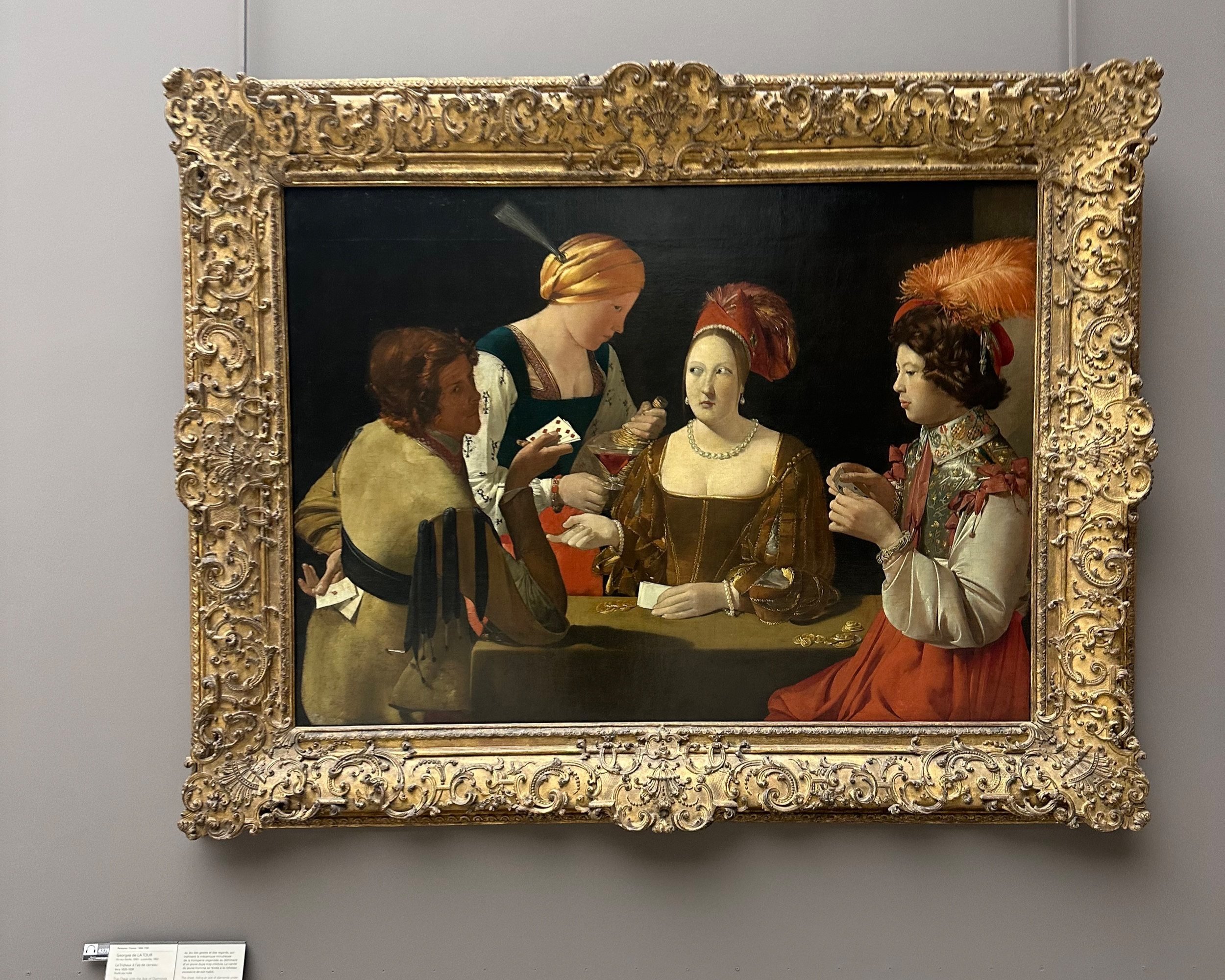Last night in the Paris 2024 Olympic Opening Ceremony for the ages a few heads were spotted in the Seine just past the Louvre. Not just any figures, they belong to some amazing paintings you can find inside the Louvre.
Starting from the Pont Royal is the stunning Madeline by Marie-Guilhelmine Benoist. The actual title of the piece is A Portrait of a Black Woman. Painted in 1800 it changed the landscape of art. Madeleine was a beautiful black woman who came from Guadalupe when Marie met her. Using the classic pose that she learned under J L David she placed Madeleine on a winged chair and draped her in white fabric with a touch of blue and red in the Empire style and suddenly transformed how black models were seen.
Marie Guillemine de Laville-Leroux Benoist is a mostly unknown artist. Born December 18, 1768, in Paris into a political family which would help her enter into one of the most prestigious ateliers in Paris.
At just 13 years old she began training with Elisabeth Vigee Le Brun who was the First Painter to Marie Antoinette. Her talent was noticed and in 1784 she exhibited for the first time at the Salon a painting of her father. The 18th century wasn’t kind to female painters but under the lead of Le Brun, she was able to traverse the art world and get noticed by a few of the biggest names.
In 1788, Marie was asked by Jacques Louis David to join his atelier. The king of the Neoclassical movement was happy to take women in as a way to get back at King Louis XVI who forbade women artists to train in the Louvre. At the time David lived and had his studio in the Louvre. Most women were relegated to painting flowers & landscapes, but David suggested she try her hand at historic subjects.
In 1800 she created a painting that changed the landscape of art. After a visit to her brother-in-law's home, she met Madeleine and decided to paint a subject that was rarely seen in art at the time. Madeleine was a beautiful black woman who came from Guadalupe when Marie met her. Using the classic pose that she learned under David she placed Madeleine on a winged chair and draped her in white fabric in the Empire style and suddenly transformed how black models were seen.
The model was unknown until a few years ago before an exhibit at the Orsay unveiled her name. On June 27, 1818, the Director of the Maison du Roi purchased the painting with three of her other paintings. Under Louis XVIII the painting was sent to the Louvre. I wish she was somewhere where more people could discover her but until that day, be sure to search for her when you visit the Louvre.
The next woman is featured in George de La Tours The Cheater with the Ace of Cards painted in 1636. Three grifters work together to steal the money of a rich young man by hiding an ace behind one of their backs. Our lady in the Seine is the Courtesan with a red hat decorated with an ostrich feather and pear drop earrings. The pearls are the giveaway that she is a prostitute.
And you thought pearls were so classy.
Next, we have Muhammad Qasim’s Portrait of Shah Abbas Ier drawn in 1627. Sadly not on display in the Louvre at this time. The painting is of the Shah and his page boy who clutches a wine flask near the elder’s lap. I’ll let you figure out that symbolism. On the painting is a quote:
“May life provide all that you desire from three lips: those of your lover, the river, and the cup.”
Rather fitting on the banks of the Seine.
My other favorite painting that is sure to always catch the visitor’s eye is the presumed portrait of Gabrielle d’Estrées and her sister the Duchess of Villars. There is still a lot that is unknown about this painting, including that of the subject and the artist. Attributed to the Fontainebleau School in 1594, it is believed to be Gabrielle and her sister, the Duchess of Villars who held her nipple between her fingers, which was a gesture symbolizing pregnancy. Gabrielle would have been five months pregnant with the future Duke of Vendome, Henri IV’s illegitimate son. In Gabrielle’s left hand, she holds a ring between her fingers, the coronation ring of Henri– a token of his love and loyalty. In the background sits a woman sewing, could it be baby clothes.
Gabrielle d’Estrées is a woman known more for her risque painting than for her life itself. Gabrielle was born around 1573, and daughter of Antoine d’Estrées, Baron de Boulonnois and Françoise de la Bourdaisieres. She was one of eleven children, seven of which were girls, and gave them the moniker “seven deadly sins” by the Marquis de Sevigné.
The union of Gabriele and Henri resulted in three children. Caesar in 1594, Catherine in 1596, and Alexandre in 1598. All three were legitimized in the eyes of the monarchy and the church as Henri’s children. In 1599 she became pregnant again. Each of her pregnancies was very easy, but this fourth was giving her a lot of issues. Sick every day she struggled for five months.
On April 6, 1599, she left Henri behind at Fontainebleau, it was just a few days before their wedding planned for April 11, Easter. She cried and sobbed and had to be pulled off of him, on what would be the last time she saw her love. On April 7 she dined with Sebastion Zamet, an Italian who had arrived in France with Catherine de Medici and was also close with Marie de Medici. That night at dinner when she said she wasn’t feeling well, Zamet gave her a frosted lemon. The next day she began having contractions and pains, she was only 5 months along.
The baby had already died and doctors tried to figure out what to do as she got worse. After a day her face and neck suddenly turned black leaving the doctors baffled. When word finally reached Henri at Fontainebleau he travelled to Paris as fast as he could but it would be too late. On April 10, at just 26 years old Gabrielle would die, the day before their intended wedding.
Distraught, Henri planned a lavish funeral at the Eglise Saint Germain l’Auxerrois fit for a queen. Henri dressed in black for months, shocking most as white was the normal color for royals in mourning. A lifelike effigy was created and placed in the room next to his where he would sit with her and eat his meals.
Gabrielle was buried at the Abbey de Maubuisson where her sister was a nun and her children stayed close to their father. Less than a year later Henri would marry Marie de Medici.
Listen to Gabrielle’s story here
Each one of the figures has a story. A mistress, a courtesan, a former slave, and a gay man. If they had shown the entire painting many viewers may have clutched their pearls but here, we see them as perfection.






